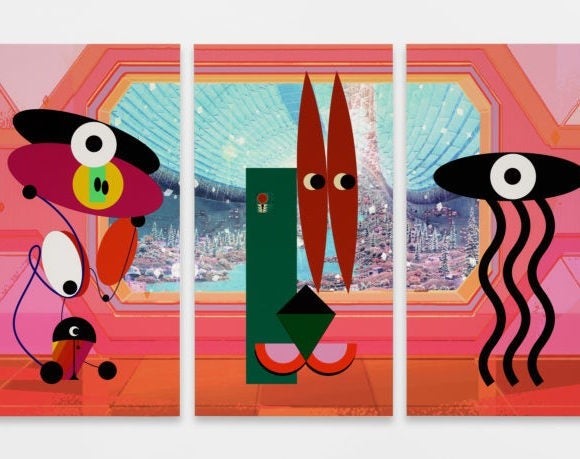Playboard

Ad Minoliti solo show.
Since she started painting, and well before she turned towards an artistic career and discovered feminist theory, Ad Minoliti has been exploring the unexploited possibilities that form a dialogue between colour, geometry, sexuality and politics. Born in Buenos Aires in 1980, the young Ad soon saw that she was growing up in a world made for white cis men, by white cis men, and even modern and contemporary art, which should be progressive and break with the patriarchal customs that surround it, reproduced this partiality, with its own codes and sometimes great subtlety.
The exhibition Playboard feeds on the experience of the Feminist School of Painting which the artist set up last autumn at the Kadist Foundation of San Francisco, for her first institutional exhibition in the USA. She there produced an environment closer to a centre of resources than a traditional show. In this ephemeral school, she led a succession of seven workshops, each orientated towards a specific painting genre. The portrait, the landscape, history, still life, the “petit genre” as she calls it (and which is more often called “genre scene”) were thus explored, through a queer approach, by a group of artists, authors and academics.
These genres were to be found again, a few months later, in the paintings of the exhibition Playboard. For example, the portrait, as a depiction of an identified person, for long limited to people with a certain social importance. But Minoliti instead displays an indeterminate geometric character – without origins, gender or class, midway between Donna Haraway’s cyborgs and the robots of her childhood manga, which colonise excessively tropical forests (Selvas) with spatial landscapes that the artist has produced for the first time (Abstraccion geometrico galactica / Geometries on Space). A landscape, thus, for which the very word was coined because it was closely linked to the depiction of a land or country. In this case it is propelled into space, taking its forms from the illustrated propositions for spatial colonies that NASA commissioned from artists during the 1970s, thus exporting beyond the terrestrial sphere its White American Way of Life. In this case contaminated by Minoliti’s techno-feminist figures. For a major genre, we can see the Furies, divinities from Hell for the Romans, charged with executing the sentences of the earth’s judges on the guilty, and the Cyclops, which mark the exhibition with their omnipresent eyes, becoming amalgamated with the cheekier stare of cats, another recurrent figure in the show. The cat, often associated with femininity in the domestic, intimate space, and also associated to witches, creeps in everywhere, as a cunning being, not hesitating to overturn codes and conformities.
Together, this new series of Minoliti’s paintings build up a ludic itinerary, punctuated by references to a childhood aesthetic, like a game of snakes and ladders, deliberately turned towards a future (at last) freed from macho, colonialist and supremist mythologies. After exploring the non-human, post-gender alternative universe, the artist is now addressing the future of genres.